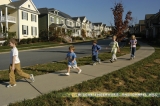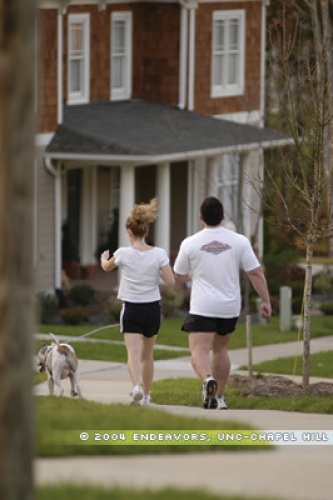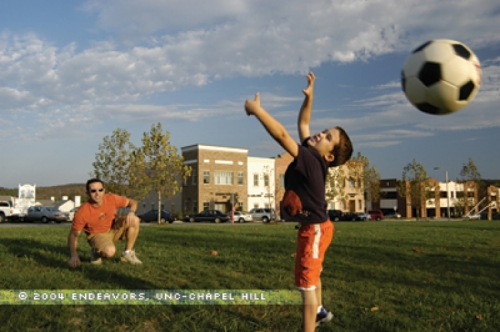For generations, the American dream has been luring us out to the suburbs — to a gadget-packed house on a big, roomy lot with a couple of late-model cars in the drive. Safe from the dirt, din, and crime of big cities, the suburbs would be good for us, we thought.
And maybe they were, for a while. Then we noticed that highways had clogged with our cars as we toiled back and forth in a haze of gray smog. Even worse, an epidemic slowly crept across the suburbs — an epidemic of obesity and its deadly accomplices, diabetes and cardiovascular disease. In 2002, 59 percent of Americans were overweight or obese. In North Carolina, the percentage rose from 43.5 percent in 1987 to 59 percent in 2002. All of that fat put a drag on the economy as it pushed health-care costs through the roof.
The cause? Fast food and too much television are the usual suspects. But increasingly, researchers in planning and public health have begun to implicate a less obvious culprit — what they called the “built environment,” much of which was built around cars.
Is suburbia killing us with idleness and fat?
The problem isn’t so simple. All kinds of factors — social, cultural, and psychological — incline us to camp on the sofa with soft drinks and chips. But when communities organize themselves around the automobile as the primary mode of transportation, they effectively engineer physical activity right out of the equation. Children can spend as much time riding to soccer practice as they spend on the field.
“We have latch-keyed our children within the four walls of their houses and schools,” says Rich Killingsworth, research associate professor in the Department of Health Behavior and Health Education, School of Public Health, “and they are watching TV and eating and not getting out unless somebody drives them somewhere.”
Killingsworth, who came to Carolina two years ago from the Centers for Disease Control and Prevention, directs Active Living by Design, a $17 million project funded by the Robert Wood Johnson Foundation, which also supports partner projects at San Diego State University and at Texas A&M. The focus of work at UNC-Chapel Hill, Killingsworth says, is to examine how people and their communities make decisions that encourage or discourage physical activity. Killingsworth was one of five authors of an article in the September/October 2003 issue of the American Journal of Health Promotion, reporting a small but significant association between urban sprawl and health risks.
“When we looked at the data across the United States, we found that as communities became less compact — sprawled out — they showed higher prevalence of hypertension, obesity, and less physical activity,” Killingsworth says.
Active Living by Design will examine twenty-five communities nationally, looking at factors in transportation, education, law enforcement, city planning, architecture, and urban design. Chapel Hill, the only study site in North Carolina, offered an unusual chance to study a community already aspiring to some of the project’s key goals.
“Chapel Hill is well suited to what we’re trying to achieve,” Killingsworth says. “It’s built on a small-town concept, and decisions generally are made here with people in mind. You can see it in the influence of committees working on everything from bike paths to green space. And it’s one of the few towns in America where the schools are fully connected with the sidewalk system.”
Testing New Urban Ideals
Chapel Hill also includes two neighborhoods of keen interest to urban planners — Meadowmont and Southern Village, both of which were built more or less on the model of New Urbanism. The idea is to promote high-density urban development that integrates schools, businesses, green space, and recreation facilities, reducing the dependence on cars. Killingsworth, who lives in Southern Village and pedals a bike to his office on Market Street, says it’s too early to tell whether these experiments in neighborhood design will make people more active. Yes, children do seem to be walking to school, and on mild evenings joggers and dog-walkers share the sidewalks with baby strollers and rollerbladers. But there’s also evidence that people moving into high-density developments are slow to shed the habits of sedentary suburbia. For one thing, they can’t resist their cars.
“We grow up with the understanding that the only way to travel is by car,” Killingsworth says, “and the only way for communities to develop is with a separation of uses — we put homes in one place and we put businesses in another and parks over here and schools over there.”
Segregating zones made sense in the days when the typical workplace was a noisy factory belching smoke. But today, most people work in relatively clean, presentable buildings that could easily share neighborhoods with houses and schools. Building workplaces, shopping, and schools into the same neighborhood could eliminate trips in the car and make walking or biking routine.
So far, this kind of mixed-use neighborhood represents only about one percent of the development in the United States, Killingsworth says. Changing the pattern will require more than a health-minded interest in walking and biking. Businesses and governments will have to see the economic advantage of having people out and about without cars. Take the Franklin Street corridor in Chapel Hill, for example. Businesses there would benefit, Killingsworth says, if nearby neighborhoods such as Southern Village were better connected to the corridor by sidewalks and bike paths.
“Sometimes, a few low-cost accommodations for pedestrians can lead to significant improvements in the vitality of a business district,” Killingsworth says.
Luring Us Out of Our Cars
But even if the New Urban movement caught on, would Americans really spend less time on the well-padded cushions of sofas and cars? Would we all begin walking to work or school, getting at least thirty minutes of moderate exercise every day, which is what the Surgeon General says we need?
Asad Khattak, associate professor of city and regional planning, recently led a study, funded by the North Carolina Department of Transportation, comparing physical activity and transportation behavior in Southern Village with those in a traditional subdivision having larger lots and no schools or businesses. Preliminary results indicate that residents in both neighborhoods spend about the same amount of time in leisure activity. But when Khattak and his team compared utilitarian outings — walking or bicycling to work, to school, to the market, or to the bus stop, for instance — Southern Village residents were three times more likely to go by foot or bicycle than were their counterparts in the traditional subdivision.
At first glance, that finding seems obvious: Southern Village has bus stops, businesses, and a school. But until the team gathered data, there was no way to assume that offering such amenities within walking distance would actually encourage people to walk. Even when Americans accept the need for exercise, we generally reach for our car keys on the way out the door. Daniel Rodríguez, assistant professor of city and regional planning and a contributor to Khattak’s study, says that Americans tend to think of exercise as a separate activity apart from our daily routine. “People drive down to the shopping mall to walk, or they drive to the gym,” Rodríguez says. “So that’s the current pattern: we’re trying to reconcile our desire to drive a car with the desire to exercise.”
Rodríguez knows that it’s an uphill battle to separate Americans from their automobiles. One possible answer, he says, is to keep the car but not drive it so much. He describes the example of Stockholm, Sweden, a city built around public transit. Rodríguez says that the Swedes are among the world’s leaders in per capita ownership of cars. And their cars tend to be big and heavy, perhaps because of a preoccupation with safety. “The difference is, the Swedes don’t drive their cars to work every day,” Rodríguez says. “They drive them infrequently, on weekends and holidays, when they take trips to the country.”
Even in Chapel Hill and Carrboro, people seem to be warming to public transportation. In January 2002, the local bus system became fare-free, funded in part through Chapel Hill Transit’s partnership with the university, which taxed departments and raised parking fees to cover some of the costs. Ridership increased dramatically to 4.5 million a year on the system’s regular routes.
In Rodríguez’ view, the strategy worked. “The bus system here is now very good,” he says. “Of course, it can improve. Ideally, you would have buses running during more times of the day, so there is less waiting.” In Bogota, Colombia, Rodríguez’ hometown, the city bus system moves more people than the Washington, D.C. metro, at a fraction of the cost. And nobody waits.
Building Exercise into the City
Cities with strong public transit systems tend to develop high-density clusters of neighborhoods and businesses within reach of the buses and trains. But even in high-density neighborhoods, patterns of development vary greatly, Rodríguez says, and researchers are only beginning to get a feel for what kinds of infrastructure promote or suppress physical activity. To learn more, Rodríguez is leading a high-tech study of how the built environment is related to behavior. Several hundred participants in Montgomery County, Maryland, will go about their lives wearing accelerometers, devices that measure activity. Very few studies have ever attempted to correlate so precisely human activity with the surrounding neighborhood environment.
“Cities that developed densely do tend to have walkable environments in their downtowns,” Rodríguez says. “But in the South, we have more of the strip malls, and that’s the sort of development that can be so hazardous for pedestrians.” In a study of UNC-Chapel Hill commuters, Rodríguez found that as the percentage of sidewalks between people’s homes and the campus increased, so did the likelihood that commuters would walk to work or school.
Kelly Evenson, a research assistant professor in epidemiology, studies the factors that influence people to be active. Recently, she teamed with Dianne Ward in nutrition to survey the behavior of students in public schools nationally. (Coauthors were also Phil Bors at Active Living by Design, Sara Huston in the UNC-Chapel Hill Department of Epidemiology and the N.C. Department of Health and Human Services, and Brad McMillen of the N.C. Department of Public Instruction.) In a study published in September 2003 by the journal Archives of Pediatric Adolescent Medicine, Evenson reported that 9.4 percent of middle-school students walk to school at least one day a week and 4.1 percent ride their bicycles that often. But for students in high school, those numbers decline to 4.9 percent and 2.8 percent.
Evenson’s data reveal a paradox: the high-school-age children of less-educated parents were more likely to walk to school than were the high-school-age children of well-educated parents. But among adults, higher education correlates with higher levels of leisure activity. So the parents who exercise are the very ones most likely to ferry their children to soccer or school in the family SUV. Why?
“In general, when you ask parents why their children don’t walk or ride a bike to school, one reason has to do with safety,” Evenson says. “Some parents just don’t feel that it’s safe to send their children out to cross busy streets and highways, not only because of the dangers of traffic but also because of the possibility of exposing them to crime.”
Equity and Health
Presumably, having a school in a safe neighborhood designed to accommodate pedestrians — with paths and sidewalks to separate kids from busy thoroughfares — would increase the appeal of walking and biking. But safe neighborhoods with sidewalks and schools nearby also tend to be expensive. Even though housing in each of Chapel Hill’s New Urban developments ranges from modest apartments to large, single-family houses, none of it could be described as low income.
Emil Malizia, professor and chair of city and regional planning, points out that low-income neighborhoods tend to be situated near highways, factories, or other undesirable features, and are noisier, dirtier, and more dangerous than affluent neighborhoods. “Equity is a serious issue for planners,” he says. “People in the lower-income category are the very group most vulnerable to the health risks.” He argues that urban planners should do more to factor in the health of low-income residents.
Not every planner feels at home with the subject of health. For too long, Malizia says, planners and public-health experts have gone their separate ways. It wasn’t always thus. “Historically,” Malizia says, “our profession came out of the same reforms that led to the public health profession, in the later half of the nineteenth and early twentieth century, when cities began to pave their streets and put in public sewers.” At the same time, planners were designing better housing and creating public parks to reacquaint city dwellers with the invigorating influences of green plants and fresh air. But by the 1920s and 30s, the zeal for creating more livable cities crossed a line into what Malizia calls “physical determinism,” a view that environment dictates behavior. As that view fell into discredit, the pendulum swung the other way, and public-health professionals turned their attention from the environment to the individual, Malizia says. The two professions specialized and fell out of touch.
Malizia is trying to change that. He has asked faculty and students to work more closely with the School of Public Health. A new dual-degree program allows students in public health to pursue a master’s in regional planning, one of two or three such programs nationally. For Malizia, reacquainting planners with the issue of public health is a way to steer his profession back toward the crux of America’s most urgent problems.
“Planners are perceived as dealing with issues that are important but not critical,” he says. “The focus has been on livability and quality of life, which are important, but it’s hard to know exactly what they are. We have to return to a focus on health and safety. These have to be our primary concerns: public health and public safety.”
As an academic, Malizia is reluctant to seem melodramatic as he describes what’s at stake — for his profession and for American society. But there is no easy way to soft-pedal the risks.
“It seems to me that in an era when we have an aging population, and when chronic diseases such as obesity and diabetes are becoming just as dangerous as typhoid fever and polio were to previous generations, we are engaged in matters of life and death,” he says.
“I wouldn’t say that what we’re doing will increase or decrease mortality, but the crisis looms so large from a public-health standpoint and as an economic burden that we have to incorporate it into our thinking.”
Neil Caudle was the editor of Endeavors for fifteen years.
The Active Living by Design web site is at www.activelivingbydesign.org/. Daniel Rodríguez’ commuter study will be published in the journal Transportation Research Part D.








